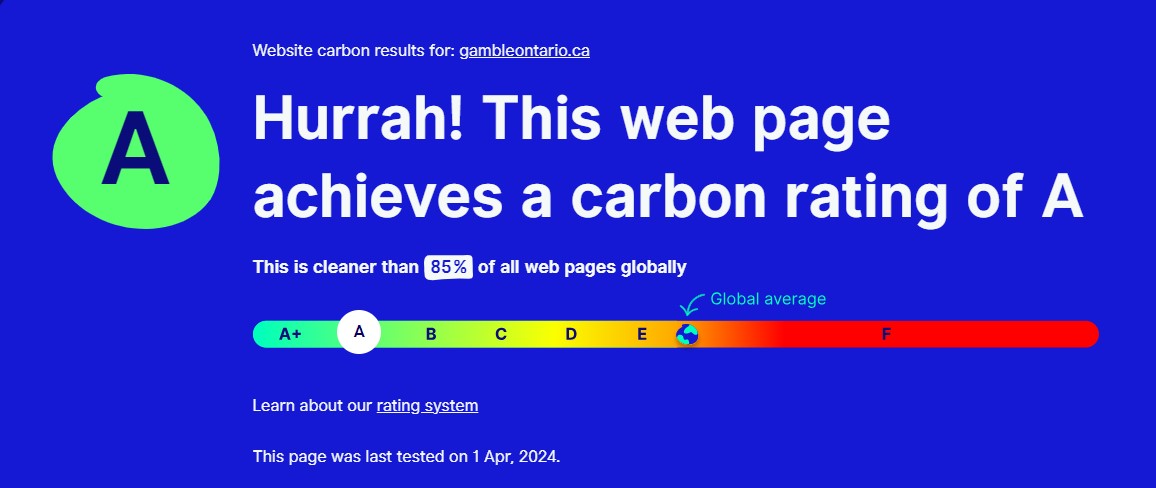Our Environmental Commitment
In the fast-paced world of iGaming, we’re keenly aware of the impact our digital presence can have on the planet.
This page is dedicated to shedding light on how online gaming activities can affect our environment, from the energy needed to keep our games running to the broader ecological footprint of our operations.
We’re keen to share the steps we’re taking to lessen our impact. From optimizing the efficiency of our digital infrastructure to embracing sustainable practices, we’re committed to making our website as eco-friendly as possible.
Dive into this page to learn more about the environmental challenges within the iGaming industry and discover the proactive measures we’re implementing to ensure a greener future.
Join us on this journey towards more sustainable gaming practices, where every click contributes to a healthier planet.

🌲 The Environmental Challenges of the Gambling Industry in 2025
The gambling industry, both online and land-based, is currently facing environmental challenges related to high energy consumption, electronic waste production, and a significant digital carbon footprint.
Online platforms, for instance, depend heavily on energy-intensive data centers, which are projected to triple their energy consumption over the next decade, contributing to global warming.
Land-based casinos also have a considerable impact through their operational energy use and waste.
This situation calls for the industry to embrace more eco-friendly practices to mitigate these environmental impacts.
How Does The iGaming Industry Affect the Environment?
The iGaming industry, while experiencing significant growth and technological innovation, is facing several key environmental challenges.
One major issue is the high energy consumption associated with powering the vast data centers required for online platforms.
These data centers are essential for the operation of online casinos and betting sites, but they consume a substantial amount of electricity, much of which is generated from non-renewable sources, contributing to the industry’s carbon footprint.
Another challenge is the production of electronic waste through outdated gaming technology and equipment, which poses disposal and recycling issues.
The digital infrastructure itself, necessary for the seamless operation of iGaming services, has a significant carbon footprint, further exacerbating environmental concerns.
There’s a growing emphasis on sustainability within the sector to address these issues. Measures such as using renewable energy sources for data centers, improving energy efficiency, and adopting greener technologies are being explored to mitigate the environmental impact.
The industry is also considering more sustainable practices across its operations, from game development to the end-user experience, aiming to reduce electronic waste and lower its overall carbon footprint.
What is the Environmental Impact of Land-based vs Online Gambling?
While land-based casinos traditionally have a more direct environmental impact through physical infrastructure and traffic, online casinos contribute to digital pollution and have a growing energy demand that cannot be ignored.
Both industries are at different stages in addressing their environmental impacts, with room for improvement in adopting more sustainable practices.
Comparing the environmental impacts of online versus land-based gambling reveals significant differences, with each having its own set of environmental concerns.
Land-based casinos, often large facilities, consume considerable amounts of energy for operations, including lighting, heating, and powering gaming machines. These establishments also contribute to soil erosion, generate traffic and associated emissions, and can even lead to local ecological disruptions.
On the other hand, online casinos rely heavily on data centers for their operations, which are significant energy consumers due to the need to power servers and cool the equipment.
Despite having a smaller carbon footprint than land-based casinos, online platforms’ energy demands grow with the industry, potentially leading to substantial energy consumption as more servers are required to handle increasing customer numbers.
It’s noteworthy that both types of land-based and online gambling establishments share similar environmental concerns, such as the need to reduce their carbon footprint and make positive community impacts.
Land-based casinos have been observed making efforts to contribute positively to local communities and environments, such as investing in public transport or using alternative energy sources.
In contrast, online casinos, being relatively new entities, face fewer regulations requiring them to adopt eco-friendly practices, though the industry is beginning to acknowledge these responsibilities.
🌲 Our Environmental Cause at GambleOntario
Our Environmental Cause reflects our journey towards implementing a more eco-conscious online presence.
Even though GambleOntario is a relatively new website, having been online for just two years, we are committed to minimizing our energy consumption and environmental impact.
As part of a larger corporation, we fully embrace our environmental responsibilities, actively pursuing a range of initiatives to minimize our ecological footprint.
Our strategies extend beyond mere compliance with ESG (Environmental, Social, and Governance) standards; they involve a holistic approach to sustainability.
We’ve made strides in adopting paperless workflows, encouraging the reuse and donation of IT equipment, and significantly reducing our CO2 emissions by optimizing travel and implementing remote working practices.
What’s Next?
In our ongoing effort to further diminish our impact, we seek to move towards green hosting solutions and optimizing game efficiency.
These steps not only lower our energy use and carbon emissions but also align with our core values of innovation and responsibility.
By harnessing the power of green technology, we ensure that our gaming experiences are not only thrilling but also environmentally friendly.
🌲 How We Reduce Our Carbon Footprint
We adopt a comprehensive and transparent approach to effectively reduce our carbon footprint, emphasizing the importance of accurate self-assessment and ongoing improvement.
Initially, we leverage independent tools and software for an honest evaluation of our website’s carbon footprint, steering clear of greenwashing. This initial step is crucial for establishing a baseline from which we can measure progress.
In pursuit of formal recognition of our efforts, we sought and achieved the CO2 Neutral Website certification, which attests to our commitment to offsetting the total CO2 emissions resulting from our website’s operation.
Earning this certification involves a fee calculated based on our site’s average visitor count and associated energy consumption. This fee funds climate projects, effectively neutralizing our digital presence’s CO2 emissions. For detailed calculations behind this process, visit CO2 Neutral Website Calculations.
Given the dynamic nature of our website — both in terms of growth and content size — we conduct monthly checks to assess our carbon footprint. These assessments help us track our progress.
Our recent evaluation resulted in an 85% carbon efficiency rating, a benchmark that we’re determined to exceed. For more insights into website carbon assessments, explore the Website Carbon Calculator.

💡 Our A rating indicates that around 0.186 grams of CO2 are emitted per page view on our website.
By embedding these practices into our operations, we aim to minimize our environmental impact and set a standard within the industry for sustainability and responsibility.
🌲 Our Steps Towards a Greener Website: A Closer Look
Our website’s impact on the environment is at the forefront of our minds. We’re dedicated to making GambleOntario as green as possible, blending top-notch user experience with our commitment to the planet.
Here’s how we’re making practical steps toward a more sustainable web presence:
1. Efficient File Compression
We leverage advanced compression technology to significantly reduce the size of our website’s files before they reach you. This helps our pages load faster and cuts down on the energy required for data transmission. It’s a strategic move that boosts user experience while actively reducing our website’s energy demand.
2. Optimized Browser Caching
By fine-tuning how browsers cache or store our website data, we’ve made it possible for your browser to remember our site better. This means that when you revisit, your browser has to do less work to show you our site, speeding up your experience and conserving energy in the process. It’s a win-win for both speed and sustainability.
3. Implementing Lazy Loading
We use a smart technique called lazy loading, which means our website only loads images and content as you scroll through them. It’s like turning on the lights only in the room you’re using. This approach reduces unnecessary data use, making our site faster and more energy-efficient.
4. Image Optimization
We work hard to ensure that the images on our site are as light as possible without sacrificing quality. By compressing images using tools and adopting formats like SVG, we ensure that our site looks great without bogging down loading times or using too much energy.
5. Adopting HTTPS
Moving to HTTPS, we’ve embraced a protocol that enhances our site’s security and improves its efficiency. This modern protocol streamlines how our website communicates with your browser, reducing data load times and contributing to our eco-friendly initiatives.
6. Minimizing Bot Traffic
We actively work to reduce unnecessary bot traffic, which can strain our servers. By cutting down on this kind of non-human traffic, we save energy and keep our site running smoothly for real users like you.
7. Using Content Delivery Networks (CDN)
Our use of CDNs means that we can deliver content to you from a server that’s geographically closer, which results in faster loading times and less energy use. It’s like having a warehouse in every city to cut down on delivery distances.
8. Adopting Clean Coding Practices
Our website is built on clean, efficient code that avoids unnecessary bloat. This careful approach to coding means our site not only runs better but uses less energy. It’s our commitment to keeping things streamlined and green.
9. Sustainable Web Design
From the ground up, our website is designed with the environment in mind. We opt for simple, efficient designs that require less data to load. Our site is not just easy on the eyes but also easy on the planet.
10. Regular Site Health Checks
We’re committed to continuous improvement, regularly auditing our site to find and fix inefficiencies. We ensure that we deliver a fast, user-friendly experience while staying true to our environmental goals.
List of References
Our goal is to become more environmentally conscious and learn from the mistakes of other companies that have attempted to do the same.
✅ Amazon, Google, Microsoft: Here’s Who Has the Greenest Cloud | WIRED
✅ Greener Gaming Products: Considering Environmental Impacts When Assessing Gambling- Related Harms
✅ Website performance and the hidden environmental impact of the internet
We are inspired by Canada’s ESG Reporting Requirements in 2025 and see how we can apply them in our case.
✅ Canada ESG Reporting Requirements in 2024 – Laws, Rules & Regulations
You can check out the tools we use to ensure we maintain a low environmental footprint.


